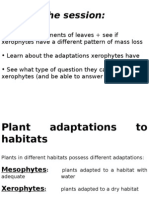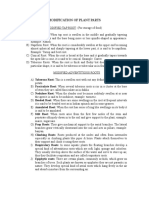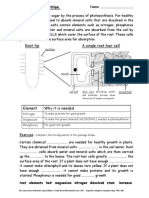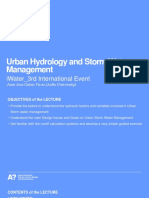0 ratings0% found this document useful (0 votes)
280 viewsXerophytes and Hydrophytes
Xerophytes and Hydrophytes
Uploaded by
Tanyaradzwa MugutaThis document discusses the adaptive features of xerophytic and hydrophytic plants. It describes how xerophytes, or desert plants, have adaptations like closing stomata, waxy cuticles, hairy leaves, reduced surface area, and deep roots to reduce water loss in dry conditions. Examples provided are succulents and cacti. Hydrophytes, or water plants, have adaptations like buoyant leaves with air spaces and lack of lower epidermal stomata to survive in aquatic environments. One example is the water lily, which has floating leaves adapted for photosynthesis in water.
Copyright:
© All Rights Reserved
Available Formats
Download as PPTX, PDF, TXT or read online from Scribd
Xerophytes and Hydrophytes
Xerophytes and Hydrophytes
Uploaded by
Tanyaradzwa Muguta0 ratings0% found this document useful (0 votes)
280 views23 pagesThis document discusses the adaptive features of xerophytic and hydrophytic plants. It describes how xerophytes, or desert plants, have adaptations like closing stomata, waxy cuticles, hairy leaves, reduced surface area, and deep roots to reduce water loss in dry conditions. Examples provided are succulents and cacti. Hydrophytes, or water plants, have adaptations like buoyant leaves with air spaces and lack of lower epidermal stomata to survive in aquatic environments. One example is the water lily, which has floating leaves adapted for photosynthesis in water.
Original Description:
Biology
Original Title
XEROPHYTES AND HYDROPHYTES
Copyright
© © All Rights Reserved
Available Formats
PPTX, PDF, TXT or read online from Scribd
Share this document
Did you find this document useful?
Is this content inappropriate?
This document discusses the adaptive features of xerophytic and hydrophytic plants. It describes how xerophytes, or desert plants, have adaptations like closing stomata, waxy cuticles, hairy leaves, reduced surface area, and deep roots to reduce water loss in dry conditions. Examples provided are succulents and cacti. Hydrophytes, or water plants, have adaptations like buoyant leaves with air spaces and lack of lower epidermal stomata to survive in aquatic environments. One example is the water lily, which has floating leaves adapted for photosynthesis in water.
Copyright:
© All Rights Reserved
Available Formats
Download as PPTX, PDF, TXT or read online from Scribd
Download as pptx, pdf, or txt
0 ratings0% found this document useful (0 votes)
280 views23 pagesXerophytes and Hydrophytes
Xerophytes and Hydrophytes
Uploaded by
Tanyaradzwa MugutaThis document discusses the adaptive features of xerophytic and hydrophytic plants. It describes how xerophytes, or desert plants, have adaptations like closing stomata, waxy cuticles, hairy leaves, reduced surface area, and deep roots to reduce water loss in dry conditions. Examples provided are succulents and cacti. Hydrophytes, or water plants, have adaptations like buoyant leaves with air spaces and lack of lower epidermal stomata to survive in aquatic environments. One example is the water lily, which has floating leaves adapted for photosynthesis in water.
Copyright:
© All Rights Reserved
Available Formats
Download as PPTX, PDF, TXT or read online from Scribd
Download as pptx, pdf, or txt
You are on page 1of 23
XEROPHYTES AND HYDROPHYTES
ADAPTIVE FEATURES OF PLANTS IN
DIFFERENT ENVIRONMENTS IGCSE
BIOLOGY
ADAPTIVE FEATURES
• Key definition
• An adaptive feature is an inherited feature that helps
an organism to survive and reproduce in its
environment.
• Key definitions
• Adaptive features are the inherited functional features
of an organism that increase its fitness.
• Fitness is the probability of that organism surviving
and reproducing in the environment in which it is
found.
XEROPHYTES
• A xerophyte is a plant adapted to live in dry
conditions, for example desert plants.
• Plants that live in deserts can easily run short of
water, especially if the temperatures are hot.
• Desert plants such as succulents and cacti must
be well adapted to live in these difficult
conditions.
• All xerophytes have adaptations that help them
to survive in these difficult environments.
Adaptations of xerophytes to reduce water
loss
• Closing stomata
• Plants lose water through their stomata.
• If they close their stomata, then transpiration will slow
down.
• However, if the stomata are closed , then the plant
cannot photosynthesise, because carbon dioxide
cannot diffuse into the leaf.
• Stomata close when it is very hot and dry, or when
they could not photosynthesise anyway such as at
night.
How stomata open and close
Waxy cuticle
• The leaves of desert plants are often covered
with a waxy cuticle, made by cells in the
epidermis.
• The wax makes the leaf waterproof.
Hairy leaves
• Some plants have hairs on their leaves.
• These hairs trap moist air next to the leaf.
Stomata on the underside of leaf
• In most leaves, there are more stomata on the
lower surface than on the upper surface.
• The lower surface is usually cooler than the
upper one, so less water will evaporate.
• In desert plants ,there may be fewer stomata
than usual, and they may be sunk into deep
pits in the leaf.
Cutting down on Surface area
• The smaller the surface area of the leaf, the
less water will evaporate from it.
• Plants like cacti, have leaves with a small
surface area, to help them conserve water.
However, this slows down photosynthesis,
because it means less light and carbondioxide
can be absorbed.
Having deep spreading roots
• Desert plants may have to seek water very deep down in the soil.
• They usually have either very deep roots, or roots that spread o
long way sideways from where the plant is growing.
• Many plants even those that do not leave in the deserts have at
least some of the adaptations. For example a plant growing in the
garden may have to cope with hot, dry conditions at least some
of the time.
• Most plants have stomata on their undersides of their leaves,
which close when need arises.
• Most plants also have waxy cuticles on their leaves, to cut down
water loss.
Ferocactus a plant adapted to live in deserts
Transverse Section Through Leaf of Xerophytic Plant
Xerophytes possess some or all of
these adaptations to prevent
excessive water loss
•Stomata sunken in pits creates local
humidity/decreases exposure to air currents;
•Presence of hairs creates local humidity next
to leaf/decreases exposure to air currents by
reducing flow around stomata;
•Thick waxy cuticle makes more waterproof
impermeable to water;
Xerophytes possess some or all of
these adaptations to prevent
excessive water loss cont.
•Stomata on inside of rolled leaf creates local
humidity/decreases exposure to air currents
because water vapour evaporates into air
space rather than atmosphere e.g. British
Marram grass
•Fewer stomata decreases transpiration as this
is where water is lost;
Xerophyte adaptations summary:
Adaptation How it works Example
thick cuticle stops uncontrolled evaporation
through leaf cells
small leaf surface less surface area for conifer needles, cactus
area evaporation spines
low stomata density smaller surface area for
diffusion
sunken stomata maintains humid air around marram grass, cacti
stomata
stomatal hairs maintains humid air around marram grass, couch
(trichores) stomata grass
rolled leaves maintains humid air around marram grass,
stomata
extensive roots maximise water uptake cacti
All Cacti are xerophytes
Marram grass-an example of a xerophyte
• Marram grass (Ammophila) lives on sand dunes where water
drains away very quickly.
• It has very long roots to search for water deep down in the sand.
• Its leaves roll up into straw-like tubes in dry weather due to the
presence of hinge cells, which become flaccid as they lose water.
• Leaf rolling, along with the fact that the stomata are sunken,
helps around the stomata, reducing transpiration.
• The presence of fine hairs around the stomata reduces air
movement so humidity builds up and transpiration is reduced.
Marram grass growing on a sand dune
Transverse section of rolled up Marram grass
leaf
Marram grass as seen under a microscope
and the plan drawing
Hydrophytes :Adaptations to living in water
• Plants adapted to living in water are called hydrophytes.
• An example is the water lily (Nymphaea) .
• The leaves contain large air spaces to make them buoyant, so they float on
or near the surface .
• This enable them to gain light for photosynthesis.
• The lower epidermis lacks stomata to prevent water entering the air spaces,
while stomata are present on the upper epidermis for gas exchange.
• With land plants, most stomata are usually on the lower epidermis.
• The roots of hydrophytes, which can be poorly developed, also contain air
spaces.
• This is because the mud they grow in is poorly oxygenated and the root cells
need oxygen for respiration.
• Stems lack much support as the water they are surrounded by provides
buoyancy for the plant.
Water lily (Nymphaea)
Section through water lily leaf
You might also like
- Plant Reproduction WebquestDocument5 pagesPlant Reproduction WebquestJenny ThomasNo ratings yet
- Xerophytes and HydrophytesDocument11 pagesXerophytes and HydrophytesZainurain Idrissi School100% (1)
- XerophytesDocument21 pagesXerophytesapi-3805717100% (3)
- Plant AdaptationsDocument20 pagesPlant Adaptationsnozel77No ratings yet
- Plant PropagationDocument6 pagesPlant PropagationShiVa RaghuNo ratings yet
- 5.1 Communities and Ecosystems: Topic 5: Ecology & EvolutionDocument20 pages5.1 Communities and Ecosystems: Topic 5: Ecology & EvolutionMorgan LockeNo ratings yet
- Bioaccumulation BiomagnificationDocument11 pagesBioaccumulation BiomagnificationdellfrogNo ratings yet
- Complete HSC Agriculture Notes 2015Document105 pagesComplete HSC Agriculture Notes 2015AlexCuiNo ratings yet
- Biomes ActivityDocument3 pagesBiomes ActivitybabyduckiezNo ratings yet
- Lesson 1 Basic EcologyDocument7 pagesLesson 1 Basic EcologyEdgardo TangalinNo ratings yet
- Adaptations in Plants - Terrestrial HabitatDocument20 pagesAdaptations in Plants - Terrestrial Habitatatbatcha bat100% (1)
- Insect As Ecosystem Engineer Helina & JohariDocument16 pagesInsect As Ecosystem Engineer Helina & JohariJohari JalinasNo ratings yet
- Plant Adaptations in WaterDocument4 pagesPlant Adaptations in WaterAdelajaDalrympleNo ratings yet
- Adaptations in Dirrerent Ecosystems: Free Distribution by A.P. Government 131Document17 pagesAdaptations in Dirrerent Ecosystems: Free Distribution by A.P. Government 131Y. NARASHIMHA VITTALNo ratings yet
- Asexual PropagationDocument21 pagesAsexual PropagationKenneth Fabito SoledadNo ratings yet
- Topic 5 - The Uptake and Transport of Water and MineralsDocument32 pagesTopic 5 - The Uptake and Transport of Water and MineralsAshley BedassieNo ratings yet
- 06 Plant HormonesDocument4 pages06 Plant HormonessureshthevanNo ratings yet
- Transport in PlantsDocument7 pagesTransport in PlantsMasthankhan PatanNo ratings yet
- Assignment 1 Classification, Ecology and SoilDocument2 pagesAssignment 1 Classification, Ecology and SoilLee-Anne LutchmanNo ratings yet
- ECOLOGY-1 (Compatibility Mode)Document6 pagesECOLOGY-1 (Compatibility Mode)Tony Sdj100% (1)
- Mammalian DentitionDocument5 pagesMammalian DentitionQur'Ayne Lafayette DelantarNo ratings yet
- Chapter Test Transpiration Grade 10 ICSEDocument2 pagesChapter Test Transpiration Grade 10 ICSEanirahul jtNo ratings yet
- Global EcologyDocument5 pagesGlobal EcologyLonnie AsisNo ratings yet
- Soil Formation WorksheetDocument4 pagesSoil Formation WorksheetMike UesiNo ratings yet
- Animals Class and CharDocument18 pagesAnimals Class and CharSusan Abigail Perdomo ReyesNo ratings yet
- 4-Plant Structure and FunctionDocument7 pages4-Plant Structure and FunctionfebrimetrinNo ratings yet
- Plant Physiology Lab TechniquesDocument17 pagesPlant Physiology Lab TechniquesRaheel AhmadNo ratings yet
- 2.1 Plant and Animal AdaptationDocument13 pages2.1 Plant and Animal AdaptationYeva Olensia100% (1)
- Transport in PlantsDocument24 pagesTransport in PlantsAreebNo ratings yet
- Myp 3 Cells Plants ReviewDocument23 pagesMyp 3 Cells Plants Reviewapi-238421605No ratings yet
- Unit 4 EcosystemsDocument144 pagesUnit 4 EcosystemsBlopNo ratings yet
- Modification of Plant PartsDocument3 pagesModification of Plant PartsVikas SwamiNo ratings yet
- Ecotoxicology BEGUM 2012Document156 pagesEcotoxicology BEGUM 2012javier chavezNo ratings yet
- Ecosystems - Ecology WorksheetDocument8 pagesEcosystems - Ecology WorksheetAmruta Ghayal100% (1)
- 10 Ways To Conserve The EnvironmentDocument2 pages10 Ways To Conserve The EnvironmentJosé Manuel Herrera Barba100% (1)
- Plant NutritionDocument19 pagesPlant NutritionOjok JodNo ratings yet
- Basic Plant Processes (Laboratory)Document70 pagesBasic Plant Processes (Laboratory)anon_228573261No ratings yet
- WORKSHEET 6.7 Photosynthesis - Leaf Structure (New)Document4 pagesWORKSHEET 6.7 Photosynthesis - Leaf Structure (New)netiiyah netiiNo ratings yet
- TranspirationDocument52 pagesTranspirationankurbiologyNo ratings yet
- Sparrow - Wikipedia, The Free EncyclopediaDocument6 pagesSparrow - Wikipedia, The Free EncyclopediaAli XaiiNo ratings yet
- Human Activity Impact On EnvironmentDocument29 pagesHuman Activity Impact On EnvironmentHemant KushwahNo ratings yet
- Summative ExamDocument4 pagesSummative Examapi-635545512No ratings yet
- Nutrition PlantDocument3 pagesNutrition PlantKUOKNo ratings yet
- Interdependence Among OrganismsDocument7 pagesInterdependence Among OrganismsSumi VjNo ratings yet
- Dakolias BrochureDocument6 pagesDakolias BrochureCharles IppolitoNo ratings yet
- Stages of HydrosereDocument9 pagesStages of HydroserenilaNo ratings yet
- Aquatic Plants AdaptDocument2 pagesAquatic Plants AdaptKrystallane ManansalaNo ratings yet
- Science Ecology Review Cheat Sheet: by ViaDocument5 pagesScience Ecology Review Cheat Sheet: by ViaCWRNo ratings yet
- Multiple Choice Questions: Geography-Class Viii Lesson 1 An Introduction To Resources WorksheetDocument2 pagesMultiple Choice Questions: Geography-Class Viii Lesson 1 An Introduction To Resources WorksheetDipti Raj SharmaNo ratings yet
- Apes U8 Aquatic and Terrestrial PollutionDocument4 pagesApes U8 Aquatic and Terrestrial Pollutionapi-352694884No ratings yet
- Transport and Transpiration in Plants NOTESDocument10 pagesTransport and Transpiration in Plants NOTESYasmin YehiaNo ratings yet
- CSR September 2023Document63 pagesCSR September 2023Gerd-Jan ten BrinkNo ratings yet
- CactusLexicon1977 ODocument839 pagesCactusLexicon1977 OПетър Шолеков100% (2)
- Bio102 ClassificationDocument19 pagesBio102 Classificationjoseph.covert100% (2)
- Biogeoraphical Evidence: Why Would Geography Have Anything To Do With Evolution?Document3 pagesBiogeoraphical Evidence: Why Would Geography Have Anything To Do With Evolution?Marjoeri ConstantinoNo ratings yet
- Lesson 6 Seed GerminationDocument14 pagesLesson 6 Seed GerminationSyahierah BalqisNo ratings yet
- Chapter 23 Plant PhysiologyDocument55 pagesChapter 23 Plant PhysiologyReena Clarisse AviñanteNo ratings yet
- Coastal Dunes RDADocument50 pagesCoastal Dunes RDAMagda NechitaNo ratings yet
- Nutrient Cycles: Igcse BiologyDocument19 pagesNutrient Cycles: Igcse BiologyTanyaradzwa MugutaNo ratings yet
- Biotechnology and Genetic EngineeringDocument14 pagesBiotechnology and Genetic EngineeringTanyaradzwa MugutaNo ratings yet
- Artificial Selection IgcseDocument9 pagesArtificial Selection IgcseTanyaradzwa MugutaNo ratings yet
- Organisms and Their Environment: Igcse BiologyDocument21 pagesOrganisms and Their Environment: Igcse BiologyTanyaradzwa MugutaNo ratings yet
- The Sickle Cell Allele and Malaria IgcseDocument11 pagesThe Sickle Cell Allele and Malaria IgcseTanyaradzwa MugutaNo ratings yet
- The$Guide$for$Newly$ Graduated$doctor$ $ $ $ $ Collected$By:$ DR - soran$Mohammed$$Gharib$ M.B.CH.B$ $ $ $$ $ $Document210 pagesThe$Guide$for$Newly$ Graduated$doctor$ $ $ $ $ Collected$By:$ DR - soran$Mohammed$$Gharib$ M.B.CH.B$ $ $ $$ $ $Raghib KurdiNo ratings yet
- Solid State 60 MCQsDocument62 pagesSolid State 60 MCQsDark MysteryNo ratings yet
- CAB-06-001 Issue 11 - Approved Equipment - Cables Cable AccessoriesDocument54 pagesCAB-06-001 Issue 11 - Approved Equipment - Cables Cable AccessoriesJuan BuenoNo ratings yet
- Self Direction RubricDocument1 pageSelf Direction RubricCristine Mae NavarroNo ratings yet
- Biomedical Equipment Servicing NCDocument4 pagesBiomedical Equipment Servicing NCKevin Lucaney Judan100% (1)
- Fundamentals of Smoke ControlDocument6 pagesFundamentals of Smoke ControlGia BảoNo ratings yet
- Urban HydrologyDocument39 pagesUrban Hydrologyca rodriguez100% (1)
- SRV-TSB-23-003 CR246 Spring Installation For Fuel Tank Breather HoseDocument7 pagesSRV-TSB-23-003 CR246 Spring Installation For Fuel Tank Breather Hosecarlos antonio gonzalez abregoNo ratings yet
- Why Breakfast Is So Important: EnergyDocument5 pagesWhy Breakfast Is So Important: EnergyRIMSHA MUBARIKNo ratings yet
- EDiscount Application 138Document2 pagesEDiscount Application 138Abdul JalaludinNo ratings yet
- Salman Ur Rasheed-CV PDFDocument3 pagesSalman Ur Rasheed-CV PDFbilalhanifNo ratings yet
- Headlinespatterns 170810125352Document18 pagesHeadlinespatterns 170810125352Divina ServidadNo ratings yet
- TELEFUNKEN Semiconductors: 查询ANT018供应商 捷多邦,专业PCB打样工厂,24小时加急出货Document9 pagesTELEFUNKEN Semiconductors: 查询ANT018供应商 捷多邦,专业PCB打样工厂,24小时加急出货draNo ratings yet
- WIRE LINE UNITS Spec Sheet OptimizedDocument2 pagesWIRE LINE UNITS Spec Sheet OptimizedAllanxius MaraniNo ratings yet
- Carl Yung PresentationDocument28 pagesCarl Yung PresentationShaunNo ratings yet
- En5978-5 PDMC04S30DDocument4 pagesEn5978-5 PDMC04S30DRonald BosNo ratings yet
- Problem Set 5.1Document2 pagesProblem Set 5.1Jaya SooryanNo ratings yet
- Ashish KumarDocument4 pagesAshish Kumarmritunjay kumarNo ratings yet
- Pharmaceutical Ultrapure Water Systems - : Igor GorskyDocument36 pagesPharmaceutical Ultrapure Water Systems - : Igor GorskyunknownNo ratings yet
- Idoc - Pub Control-NarrativeDocument19 pagesIdoc - Pub Control-NarrativeLisha SreeNo ratings yet
- Protist IDocument41 pagesProtist IMuhammad Nazif AzmiNo ratings yet
- Stoeckle Thaler Final Reduced 002Document30 pagesStoeckle Thaler Final Reduced 002Júnior SenseyNo ratings yet
- Tegelaar-A Reappraisal of Kerogen Formation, 1989Document4 pagesTegelaar-A Reappraisal of Kerogen Formation, 1989oreamigNo ratings yet
- Abdominal Ultrasound in Cats and Dogs, An Illustrated Reference Value Guide (VetBooks - Ir)Document49 pagesAbdominal Ultrasound in Cats and Dogs, An Illustrated Reference Value Guide (VetBooks - Ir)Abril A. MendozaNo ratings yet
- ObstertricsDocument21 pagesObstertricsgokul koutikNo ratings yet
- Tara Mandala Program Guide 2013Document44 pagesTara Mandala Program Guide 2013lapislightNo ratings yet
- Are Artificial Sweeteners Really HarmlessDocument4 pagesAre Artificial Sweeteners Really HarmlessGiorgi PopiashviliNo ratings yet
- Winters Product Catalogue 2024 WSPDocument312 pagesWinters Product Catalogue 2024 WSPventastectronica2024No ratings yet
- Psu InterviewDocument2 pagesPsu InterviewSUMITRA DEVRANo ratings yet
- Heat Exchangers: Heat Transfer Lectures Chemical Engineering Department University of Technology, IraqDocument20 pagesHeat Exchangers: Heat Transfer Lectures Chemical Engineering Department University of Technology, IraqChemical EngineeringNo ratings yet






























































































